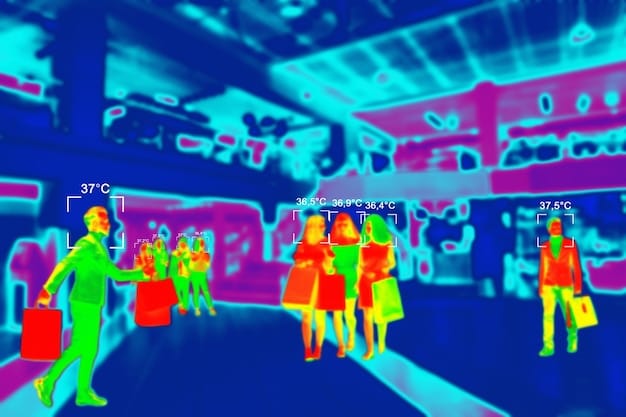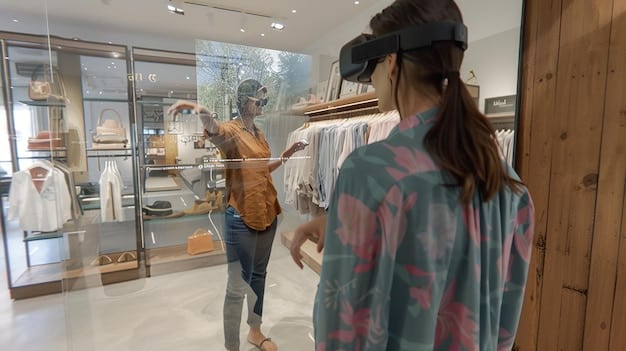Future of Retail: Adapting to Consumer Preferences

The future of retail demands proactive adaptation to evolving consumer preferences through technological integration, personalized experiences, and sustainable practices, ensuring businesses remain relevant and competitive in a dynamic market.
The retail landscape is undergoing a profound transformation, driven by shifts in consumer behavior, technological advancements, and a growing emphasis on sustainability. Understanding how businesses can effectively adapt to these changing consumer preferences is crucial for long-term success and relevance in this dynamic environment. This evolution necessitates a strategic re-evaluation of traditional retail models, embracing innovation and a customer-centric approach.
The Digital Renaissance: E-commerce and Omnichannel Integration
The digital revolution fundamentally reshaped retail, shifting consumer expectations towards immediate gratification and seamless experiences. E-commerce, once a niche segment, now serves as a primary sales channel for many businesses, necessitating robust online platforms and efficient logistics. This digital shift is not merely about having an online store; it’s about integrating every touchpoint to create a cohesive shopping journey.
Consumers no longer differentiate sharply between online and offline channels. They expect to browse online, purchase in-store, or vice versa, with inventory and customer data synchronized across all platforms. This omnichannel approach is becoming the prevailing standard.
Seamless Customer Journeys
An effective omnichannel strategy ensures that a customer’s experience remains consistent and fluid, whether they are interacting with a brand’s website, mobile app, physical store, or social media. This comprehensive integration enhances customer satisfaction and loyalty.
- Unified Inventory Management: Real-time inventory synchronization prevents stockouts and allows “buy online, pick up in-store” (BOPIS) options, a key convenience for modern shoppers.
- Personalized Interactions: Data collected from all channels informs personalized recommendations and marketing messages, making shopping more relevant to individual preferences.
- Consistent Branding: Maintaining a consistent brand voice and aesthetic across all touchpoints reinforces brand identity and builds trust.
Furthermore, the rise of mobile commerce has made the smartphone an indispensable tool for shoppers. From product research to price comparisons and mobile payments, retailers must ensure their digital presence is optimized for mobile devices, providing intuitive navigation and fast loading times. Ignoring this mobile-first trend can significantly alienate a substantial portion of the consumer base.
The imperative for retailers is not just to exist in the digital space, but to thrive by understanding how consumers move between physical and digital realms. This requires investing in technologies that bridge these gaps, offering flexibility and convenience that traditional retail models often lack. The pandemic accelerated many of these trends, turning what were once future considerations into immediate necessities for survival and growth.
The Experience Economy: Beyond Transactions
In an era where products are easily accessible online, the physical store’s role is transforming from a mere point of sale to a hub for experiences. Consumers seek engagement, entertainment, and education alongside their purchases. This shift means retailers must rethink store design, staff training, and the very purpose of their brick-and-mortar locations.
Experiential retail aims to create memorable interactions that foster emotional connections with the brand. This can range from in-store workshops and events to interactive displays and personalized consultations. The goal is to provide a reason for consumers to visit, linger, and ultimately, form a deeper relationship with the brand.
Curated Environments and Unique Services
Creating a unique in-store atmosphere can significantly enhance the shopping experience. This involves thoughtful design, sensory elements, and the provision of services that go beyond typical retail offerings.
- Immersive Brand Spaces: Stores are becoming showrooms or brand embassies where customers can fully immerse themselves in the brand’s narrative and values.
- Interactive Technology: Augmented reality (AR) mirrors, virtual try-on stations, and interactive product displays draw customers in and provide new ways to engage with merchandise.
- Personalized Consultations: Offering expert advice, styling sessions, or product demonstrations elevates the service level and builds customer trust.
The human element remains critical in this experience-driven model. Knowledgeable and empathetic staff who can act as brand ambassadors and problem-solvers are invaluable. Their ability to deliver personalized service and contribute to a positive atmosphere distinguishes the physical retail experience from purely transactional online shopping. Investing in staff training that emphasizes customer engagement and brand storytelling is paramount. This move towards experiential retail is a direct response to consumers demanding more than just a product; they want an enriched lifestyle and purpose.
Personalization and Hyper-Targeting: Knowing Your Customer
Modern consumers expect retailers to understand their individual needs and preferences. Generic marketing and one-size-fits-all approaches are becoming increasingly ineffective. The future of retail hinges on the ability to collect, analyze, and leverage data to deliver highly personalized experiences, from product recommendations to marketing messages and in-store interactions.
This level of personalization requires sophisticated data analytics capabilities, integrating customer data across all touchpoints. By understanding purchase history, browsing behavior, demographics, and even psychographics, retailers can anticipate needs and offer relevant solutions, fostering loyalty and driving sales.
Leveraging Data for Deeper Insights
Data is the new currency for retailers. Effective utilization of this data allows for a more nuanced understanding of customer segments and individual preferences, leading to more impactful retail strategies.
- Predictive Analytics: Using AI and machine learning to forecast consumer buying patterns and preferences, allowing for proactive inventory management and targeted promotions.
- Dynamic Pricing: Adjusting prices in real-time based on demand, competition, and individual customer profiles to maximize revenue and perceived value.
- Customized Product Offerings: Presenting a tailored selection of products or services based on past interactions, improving conversion rates and customer satisfaction.

The ethical implications of data collection and usage are also paramount. Transparency with consumers about how their data is used, and ensuring robust data security measures, are essential for maintaining trust. Retailers that can balance hyper-personalization with data privacy will build stronger, more sustainable customer relationships. This shift from mass marketing to individual engagement represents a significant evolution in how businesses connect with their consumer base, moving towards a truly customer-centric paradigm.
Sustainability and Ethical Consumption: Values-Driven Purchases
A growing segment of consumers, particularly younger generations, is increasingly making purchasing decisions based on a brand’s commitment to sustainability, ethical practices, and social responsibility. This shift is not just a trend but a fundamental change in consumer values, compelling retailers to integrate these principles into their core business model.
Consumers are scrutinizing supply chains, labor practices, environmental impact, and product longevity. Brands that demonstrate genuine commitment to these values, and can transparently communicate their efforts, will gain a significant competitive advantage and foster deeper trust with their audience.
Building a Responsible Supply Chain
True sustainability extends beyond simple messaging; it requires a systemic rethinking of operations, from sourcing to disposal. Retailers must engage with their entire ecosystem to implement meaningful change.
- Eco-friendly Sourcing: Prioritizing suppliers who use renewable resources, minimize waste, and adhere to fair labor practices.
- Circular Economy Models: Implementing take-back programs, repair services, and resale options to extend product lifecycles and reduce landfill waste.
- Transparent Communication: Clearly communicating sustainability efforts and certifications, building trust and allowing consumers to make informed choices.
Beyond environmental concerns, ethical labor practices, fair wages, and community engagement also play a critical role. Brands perceived as exploiting labor or neglecting social responsibility risk alienating a significant portion of their consumer base. This holistic approach to corporate responsibility signals a maturing consumer market that values purpose alongside product. Retailers who neglect these dimensions risk being seen as outdated or, worse, unethical, losing market share to more conscious competitors. This is no longer an optional add-on but a core expectation from a growing demographic.
Agility and Responsiveness: Navigating Rapid Change
The retail environment is characterized by unprecedented speed of change. Consumer preferences, technological advancements, and global economic shifts can alter market dynamics almost overnight. Businesses that thrive in this future will be those capable of rapid adaptation, continuous innovation, and flexible operations.
This requires moving away from rigid, long-term planning cycles towards more agile methodologies. Retailers need to build organizational structures that can quickly identify emerging trends, pilot new concepts, collect feedback, and scale successful initiatives or pivot from unsuccessful ones with minimal friction.
Embracing Lean and Iterative Practices
An agile organization is one that can learn and adapt quickly. This involves fostering a culture of continuous improvement and experimentation.
- Rapid Prototyping: Testing new ideas or shopping formats on a small scale before full-scale implementation, reducing risk and allowing for quick adjustments.
- Data-Driven Decision Making: Relying on real-time analytics and customer feedback to inform strategic and operational decisions, rather than intuition alone.
- Flexible Supply Chains: Building resilient and adaptable supply networks that can respond quickly to disruptions or sudden shifts in demand.
The ability to foster a culture of innovation and empower employees at all levels to contribute to problem-solving is also critical. Hierarchical, siloed organizations struggle to keep pace with rapid change. Retailers must invest in digital tools that enhance collaboration, streamline communication, and provide real-time insights across the business. This organizational flexibility is as critical as any technological adoption, enabling businesses to not just react, but proactively shape their future in a volatile market. The retailers that win will be the ones that view change not as a challenge, but as an ongoing opportunity to learn and evolve.
Technology as an Enabler: AI, AR, and Automation
Technology is not merely a tool for efficiency; it is a fundamental enabler of new retail experiences and business models. Artificial intelligence (AI), augmented reality (AR), virtual reality (VR), and automation are set to profoundly reshape how consumers interact with products and brands, and how retailers manage their operations.
AI is already powering personalized recommendations, predictive analytics, and conversational commerce (chatbots). AR and VR offer immersive shopping experiences, allowing customers to virtually try on clothes, visualize furniture in their homes, or explore digital showrooms. Automation, from warehouse robotics to self-checkout systems, enhances efficiency and frees up human associates for higher-value customer interactions.
Transformative Technologies in Action
The seamless integration of these technologies can redefine the retail experience, making it more efficient, engaging, and personalized.
- AI-Powered Personalization: Advanced algorithms creating highly individualized shopping feeds and dynamic pricing models based on real-time behavior.
- AR for Product Visualization: Allowing customers to ‘virtually’ interact with products before purchase, reducing returns and enhancing confidence.
- Robotics in Logistics: Automating warehouse operations and last-mile delivery to increase speed and reduce costs.

The key for retailers is not to adopt technology for its own sake, but to strategically implement solutions that solve customer pain points, enhance operational efficiency, and create new value propositions. This requires significant investment in infrastructure, talent, and continuous research to stay ahead of the curve. Those who embrace these technological advancements strategically will redefine the boundaries of what is possible in retail, creating competitive advantages that are hard to replicate. Ignoring these powerful tools is no longer an option for businesses aiming for sustained relevance.
Community and Connection: Building Brand Advocacy
In an increasingly digital and globalized world, consumers often seek authentic connections and a sense of belonging. Retailers have a unique opportunity to foster communities around their brands, transforming customers into advocates and creating a deeper, more enduring relationship beyond mere transactions.
This involves building platforms for interaction, celebrating shared values, and empowering customers to become part of the brand narrative. From online forums and social media groups to in-store events and loyalty programs that offer exclusive access, creating a sense of community can significantly enhance brand loyalty and drive organic growth through word-of-mouth marketing.
Fostering Customer Engagement and Loyalty
Building a strong community is a long-term investment that yields significant returns in customer retention and brand resilience.
- User-Generated Content (UGC): Encouraging customers to share their experiences and product usage, amplifying brand reach and authenticity.
- Brand Ambassadors and Influencers: Partnering with loyal customers or micro-influencers who genuinely believe in the brand to spread its message.
- Exclusive Community Access: Offering members-only content, early access to products, or unique experiences to foster a sense of belonging and exclusivity.
Furthermore, local community engagement remains vital for physical stores. Sponsoring local events, collaborating with neighboring businesses, and becoming a neighborhood hub can strengthen local ties and build goodwill. In an age of perceived digital anonymity, brands that successfully cultivate genuine human connection and a sense of shared identity will stand out. This approach humanizes the brand, making it more relatable and resilient in the face of competitive pressures, turning satisfied customers into passionate advocates and loyal supporters.
| Key Aspect | Brief Description |
|---|---|
| 🛍️ Omnichannel Integration | Seamlessly blending online and offline shopping experiences for consistent customer journeys. |
| ✨ Experiential Retail | Transforming stores into engaging spaces that offer unique events, services, and brand immersion. |
| 🎯 Hyper-Personalization | Leveraging data and AI to deliver tailored product recommendations and marketing messages. |
| 🌿 Ethical Consumption | Prioritizing sustainability, ethical sourcing, and transparent practices to meet consumer values. |
Frequently Asked Questions
▼
Omnichannel integration is vital because modern consumers expect a consistent, seamless experience across all touchpoints, whether online or in-store. It unifies inventory, personalizes interactions, and builds stronger brand consistency, catering to evolving shopping habits and enhancing customer satisfaction and loyalty.
▼
Physical stores remain relevant by transforming into experiential hubs, offering more than just transactions. They provide immersive brand experiences, interactive technology, and personalized services like workshops or consultations, creating unique reasons for customers to visit and engage with the brand on a deeper level.
▼
Data is central to understanding and adapting to consumer preferences. By collecting and analyzing shopper data, businesses can deliver hyper-personalized product recommendations, optimize marketing efforts, and anticipate future needs. This data-driven approach fosters stronger customer loyalty and improves conversion rates significantly.
▼
Sustainability and ethical practices are increasingly critical as consumers prioritize values-driven purchases. Brands committed to eco-friendly sourcing, fair labor, and transparent operations gain a competitive edge and build trust with a growing segment of conscious consumers, reflecting a fundamental shift in market values.
▼
AI and AR enhance customer experience by offering advanced personalization, such as AI-powered recommendations, and immersive interactions. AR allows virtual try-ons or product visualization in real-world settings, reducing uncertainty and increasing engagement. These technologies create more efficient, personalized, and memorable shopping journeys.
Conclusion
The future of retail is dynamic, demanding continuous adaptation and innovation from businesses. Success hinges on a multifaceted approach that embraces seamless omnichannel integration, cultivates unique customer experiences, leverages data for hyper-personalization, and champions sustainability and ethical practices. Furthermore, retailers must foster organizational agility and strategically implement cutting-edge technologies like AI and AR, while simultaneously building strong communities around their brands. Those who proactively embrace these shifts, prioritizing customer preferences and societal values, will not only survive but thrive, shaping the next era of retail.





